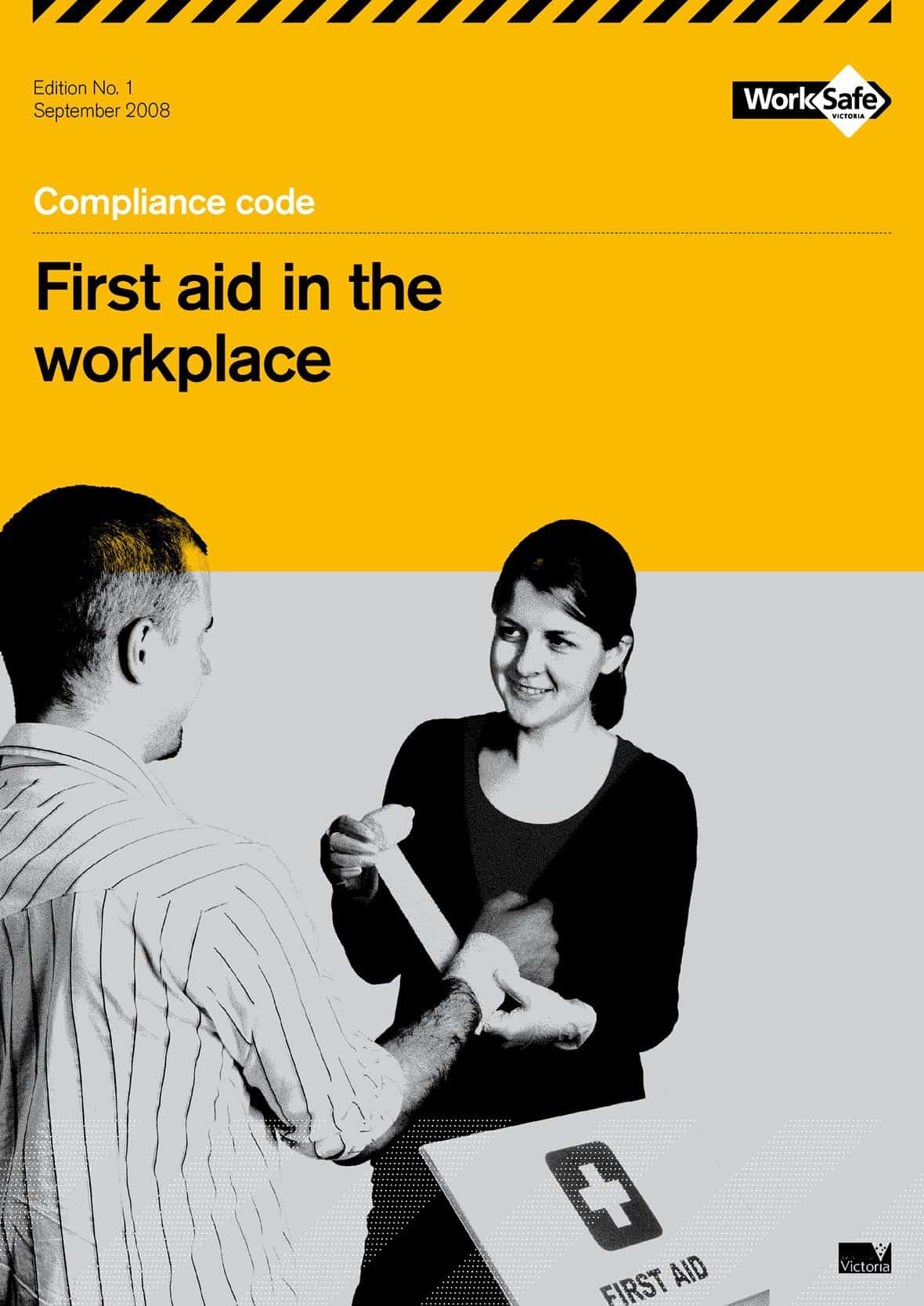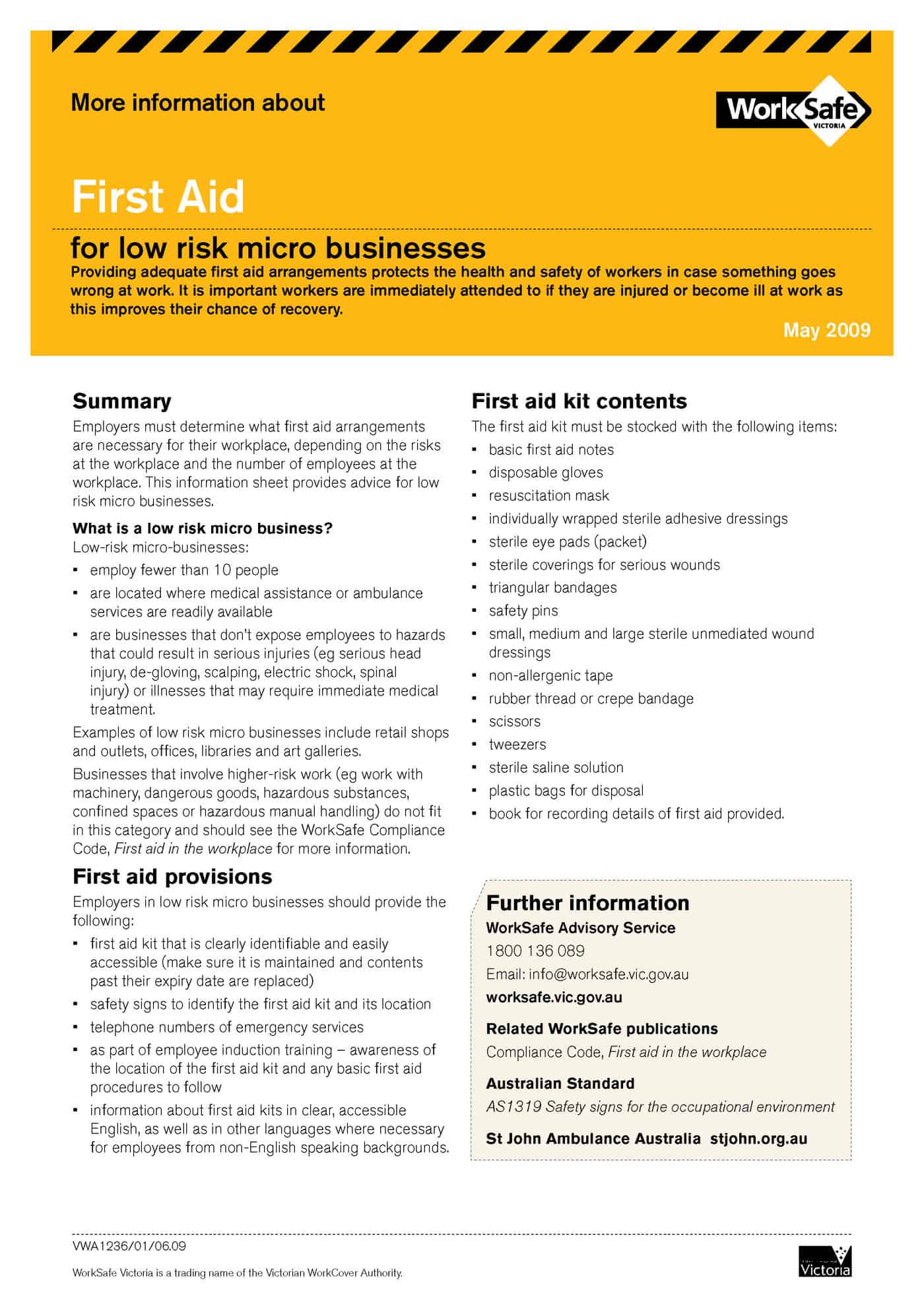 Some time ago WorkSafe Victoria issued Compliance Codes on a number of workplace safety issues. One was concerning First Aid. The Compliance Codes were intended to replace Codes of Practice which had been around for decades.
Some time ago WorkSafe Victoria issued Compliance Codes on a number of workplace safety issues. One was concerning First Aid. The Compliance Codes were intended to replace Codes of Practice which had been around for decades.
The previous major change to workplace first aid was in 1995 when the First Aid Code of Practice was reviewed in Victoria. Other Australian States vary between prescriptive and non-prescriptive first aid guidelines.
On 31 May 2009, WorkSafe released a factsheet on first aid for low risk micro businesses. A low risk micro business is explained in the factsheet as those that
- employ fewer than 10 people
- are located where medical assistance or ambulance services are readily available
- are businesses that don’t expose employees to hazards that could result in serious injuries (eg serious head injury, de-gloving, scalping, electric shock, spinal injury) or illnesses that may require immediate medical treatment.
 Some examples of low risk micro businesses were included in the factsheet – “retail shops and outlets, offices, libraries and art galleries” Why a one page information sheet for this sector was deemed to be needed is a mystery? I asked WorkSafe several questions about this factsheet
Some examples of low risk micro businesses were included in the factsheet – “retail shops and outlets, offices, libraries and art galleries” Why a one page information sheet for this sector was deemed to be needed is a mystery? I asked WorkSafe several questions about this factsheet
- What was the rationale for the production of this guidance for this sector? Given that the Compliance Code is specifically referenced.
- Is retail really a low-risk micro-business?
- What about the use of ladders?
- Young workers?
- Working alone or unsupervised?
- Occupational (customer) violence?
- Petrol stations?
- Convenience stores?
- Night shift security needs?
- Knife cuts from removing stock from boxes?
- Manual handling?
- First aid kits are required but not first aid training. In the case of respiratory failure a first aid kit is next to useless for CPR.
- Why is only St John Ambulance referenced on the guidance?
The factsheet misunderstands first aid by placing low risk microbusineses into the “paper-cut” sector. This is doing micro-businesses a dreadful disservice.
TRAINED FIRST AIDER
Shortly after the First Aid Compliance Code was released St John Ambulance broadcast an email about workplace first aid compliance. In that email St John wrote:
Low risk organisations (office, libraries, retail etc) should have at least one qualified First Aider for 10 to 50 employees…
The May 2009 fact sheet makes no mention of the need for a trained first aider but WorkSafe’s own Compliance Code states this as a compliance element.
A low-risk micro-business may not generate the potential hazards that WorkSafe lists in its definition above but employees in these businesses do have to respond to the injury needs of their customers. In these times of public liability and the expansion of OHS obligations to include customers, neighbours, and others who are affected by work processes.
WorkSafe itself describes an employee’s duty of care:
“All workers have a duty of care to ensure that they work in a manner that is not harmful to their own health and safety and the health and safety of others.”
The omission of a trained first aider is unforgivable. What would an employee do if a client collapses in the foyer of a convenience store with a heart attack or chokes on the food that they have just purchased? What would one do if a stab victim stumbles into the only open retail outlet, perhaps a petrol station, at 2.00am? How would that petrol station attendant treat someone who has had petrol accidentally splashed in their face?
These matters cannot be treated by a person who is untrained in basic first aid who only has a first aid kit available. Training for all workers who work alone or in isolation in micro-businesses is a basic element of compliance, one that WorkSafe fails to list in its latest workplace first aid factsheet.
EMERGENCY NUMBER
Almost as unforgivable is that the factsheet makes no reference to the Australian emergency number of 000. One of the first actions to be performed in a workplace where someone is seriously injured is to call for an emergency ambulance. While waiting for the medical authorities, and if safe to do so, first aid should be rendered. WorkSafe needs to remember that CPR requires training and that a first aid kit is next to useless in this type of situation.
ST JOHN AMBULANCE
It is curious that only St John Ambulance is listed on the factsheet for further information. There are many first aid equipment and training providers in Victoria. It would have been fairer to either recommend all providers or none at all.
[UPDATE: WorkSafe has advised SafetyAtWorkBlog that they will be addressing the St John Ambulance and 000 issues raised.]
COMPLIANCE CODES
On 18 September 2008, the WorkSafe website described the First Aid Compliance Code as covering
“…first aid arrangements including first aid needs assessment, first aid training, first aid kits and first aid facilities.”
In a media statement at the time on compliance codes generally WorkSafe Executive Director, John Merritt was quoted:
“The codes were developed after extensive consultation with industry, employers, employees, governmental agencies and the community to provide greater certainty about what constitutes compliance under the OHS Act.”
“The codes include practical guidance, tools and checklists to make it easier for duty-holders to fulfil their legal obligations.”
Mr Merritt added that: “These codes will provide Victorian employers, workers and Health and Safety Representatives with certainty and assistance in meeting their responsibilities.”
The Compliance Codes are aimed at the many dutyholders yet one of the rationales for the new single sheet guidance is that dutyholders (employers) do not read Compliance Codes. It seems that the Codes are now principally read by OHS professionals and advisers.
(This position may be one of the reasons WorkSafe is pushing so hard for a truly professional OHS structure through its HaSPA program – the establishment of an OHS middleman between the rules and their application in the real world.)
It is a considerable change to the readership the Compliance Codes were aimed at and is a substantial change from the Codes of Practice which, in the case of First Aid, were handed out to all first aid trainees, included in information kits for health & safety reps, and were read by dutyholders and integrated into their OHS management practices.
The significance of Compliance Codes and Codes of Practice at the moment is that these documents are to be part of the Federal Government’s move to harmonisation of OHS laws. (Some eastern States have already begun joint publication of guidances). Variations in these documents, often the most referred-to OHS documents in workplaces across the country, will undercut the aim of harmonisation – the reduction of business compliance costs through harmonised OHS requirements. If the practical application of laws are not harmonised, the aims will never be met and the process could be seen as seriously flawed.


